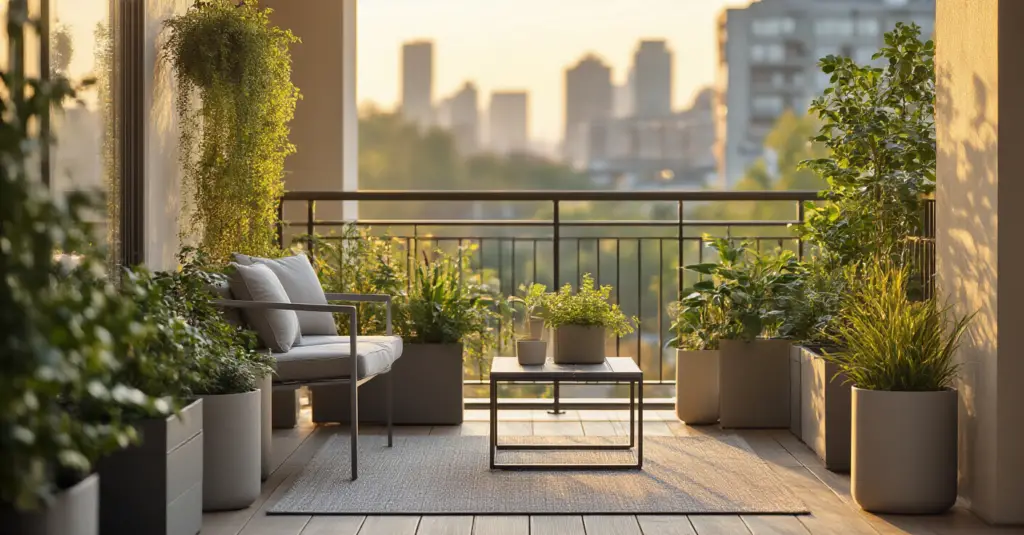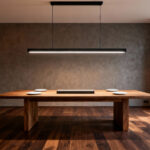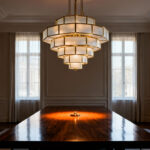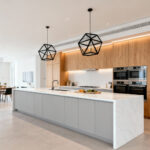Picture this: You’re standing in front of your sliding glass door, looking out at your balcony. What do you see? Is it a sad collection of dusty chairs, a bike, and maybe a forgotten planter? A concrete slab you only step onto to see if it’s raining? That space isn’t just extra storage. It’s an outdoor room waiting to happen—an escape pod from the four walls you live inside all day. It’s potential.
The problem is that most advice out there is either impossibly grand or just plain generic. It doesn’t get to the heart of it. Designing a balcony isn’t about just buying cute stuff; it’s about shaping an experience. It’s about understanding how your brain responds to space, light, and nature. As someone who lives at the intersection of psychology and design, I can tell you that a well-designed balcony can genuinely lower your stress, boost your creativity, and make your entire apartment feel bigger and better. So let’s cut through the noise and talk about what actually works.
Foundations & Safe Planning Essentials
Okay, I know. This is the boring part. The vegetable portion of the meal. But trust me, you can’t skip this, or your design dreams could turn into a literal nightmare. Getting the foundation right is what gives you the freedom to be creative without worrying that you’re going to get an angry email from your landlord—or worse.
1. Assess Balcony Weight Capacity Safely Before Furnishing.
You know what people always ask me? “Can my balcony really collapse?” The answer is, yes, it absolutely can. It’s rare, but it happens when people treat a balcony like it’s a living room floor. It’s not. It’s a platform hanging in the air, and there are very real limits to what it can hold. Ignoring this is the single most expensive and dangerous mistake you can make. It’s not about being paranoid; it’s about being smart.
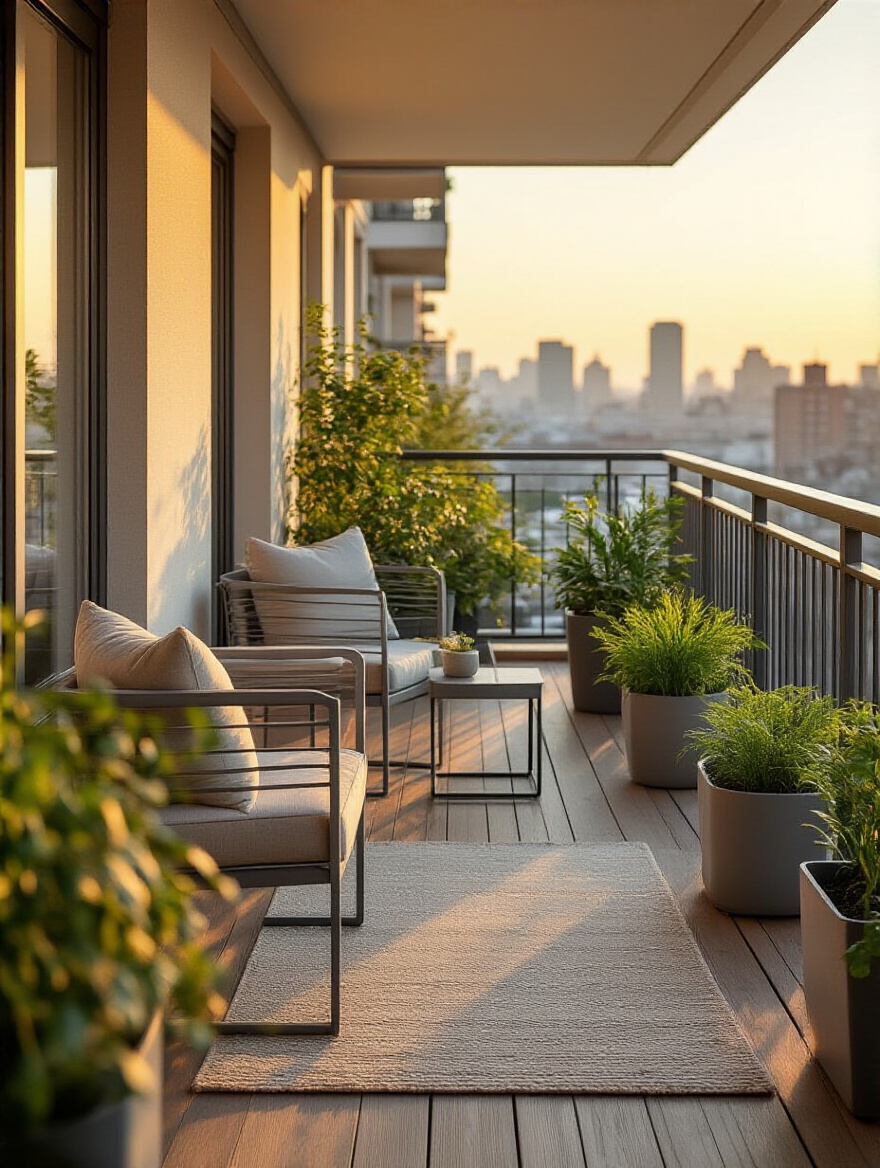
What matters here is understanding that wet soil is shockingly heavy. A few large ceramic pots filled with soil and water can easily weigh hundreds of pounds. Add a couple of people, some solid wood furniture, and you’re testing the limits. The shortcut here is simple: email your building management or HOA. Right now. Just ask, “What is the live load capacity for my balcony?” They have to tell you. This one email is your non-negotiable first step. The BS is assuming that because a neighbor has a bunch of heavy stuff, you can too. Their balcony might have different structural supports. Never assume.
With that vital safety check done, you have to make sure you’re not about to break any of your building’s rules.
2. Understand Apartment Lease Rules for Permissible Balcony Decor.
Can we talk about why so many people get into fights with their landlords over balconies? It’s almost always because they skipped this step. Your lease is not just a bunch of legal jargon; it’s the rulebook for how you can use your space. Violating it can mean fines, being forced to undo all your hard work, or even getting an eviction notice. It’s a terrible feeling to pour your heart into a space only to have to tear it down.
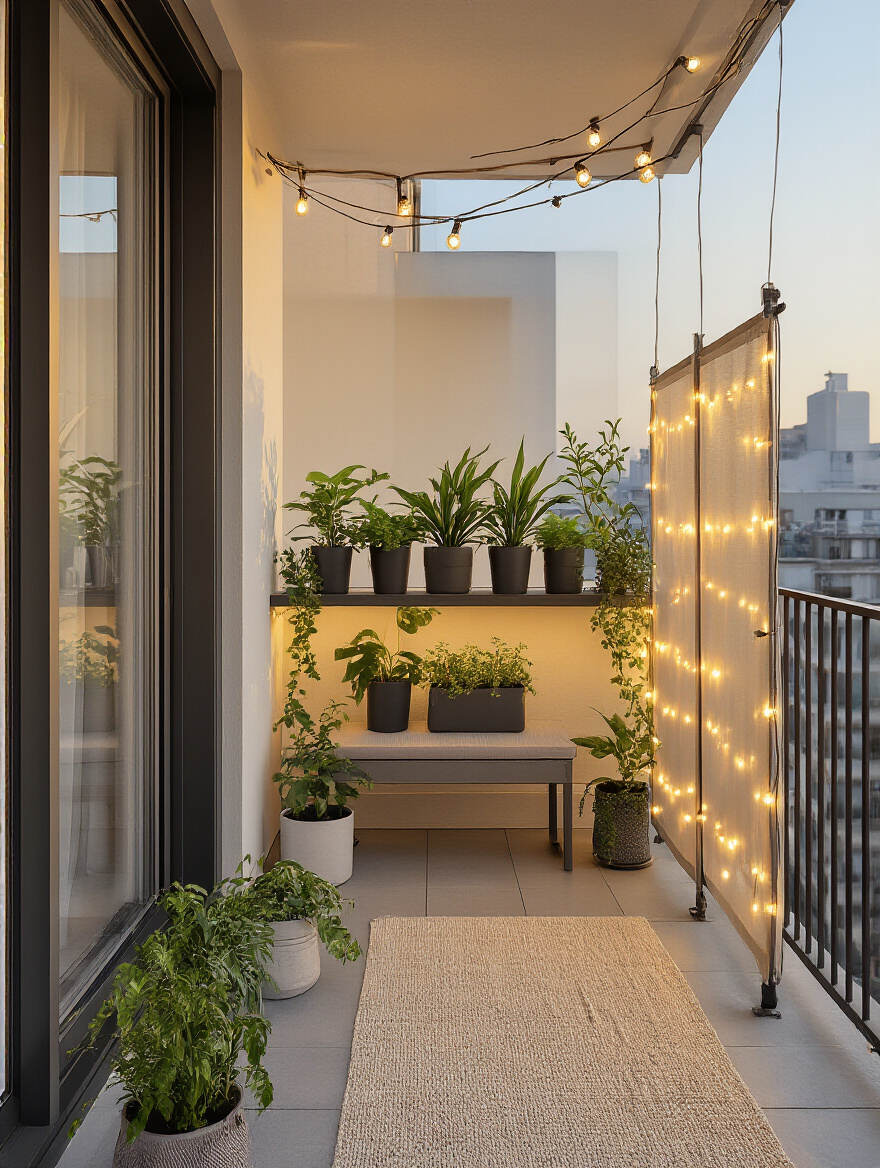
The key is to read your lease and look for keywords like “balcony,” “patio,” “exterior alterations,” or “decorations.” They usually have specific rules about what can hang over the railing (often, nothing), whether you can drill into walls, and what kinds of things are fire hazards (like most grills). The shortcut? If you’re unsure about something, get permission in writing. An email is perfect. It creates a paper trail that protects you. The BS everyone tells themselves is, “It’s better to ask for forgiveness than permission.” Not with a lease. It’s really not.
Now that you know the rules, it’s time to understand the physical space you’re working with.
3. Measure Balcony Dimensions Precisely to Guide Furniture Choices.
I once watched a client try to return an entire outdoor sofa because it wouldn’t even fit through their apartment door to get to the balcony, let alone fit on the balcony itself. It was a logistical nightmare. Buying furniture without measuring first is like getting dressed in the dark. You might get lucky, but you’ll probably look ridiculous and feel uncomfortable. Precision here saves you so much time, money, and frustration.
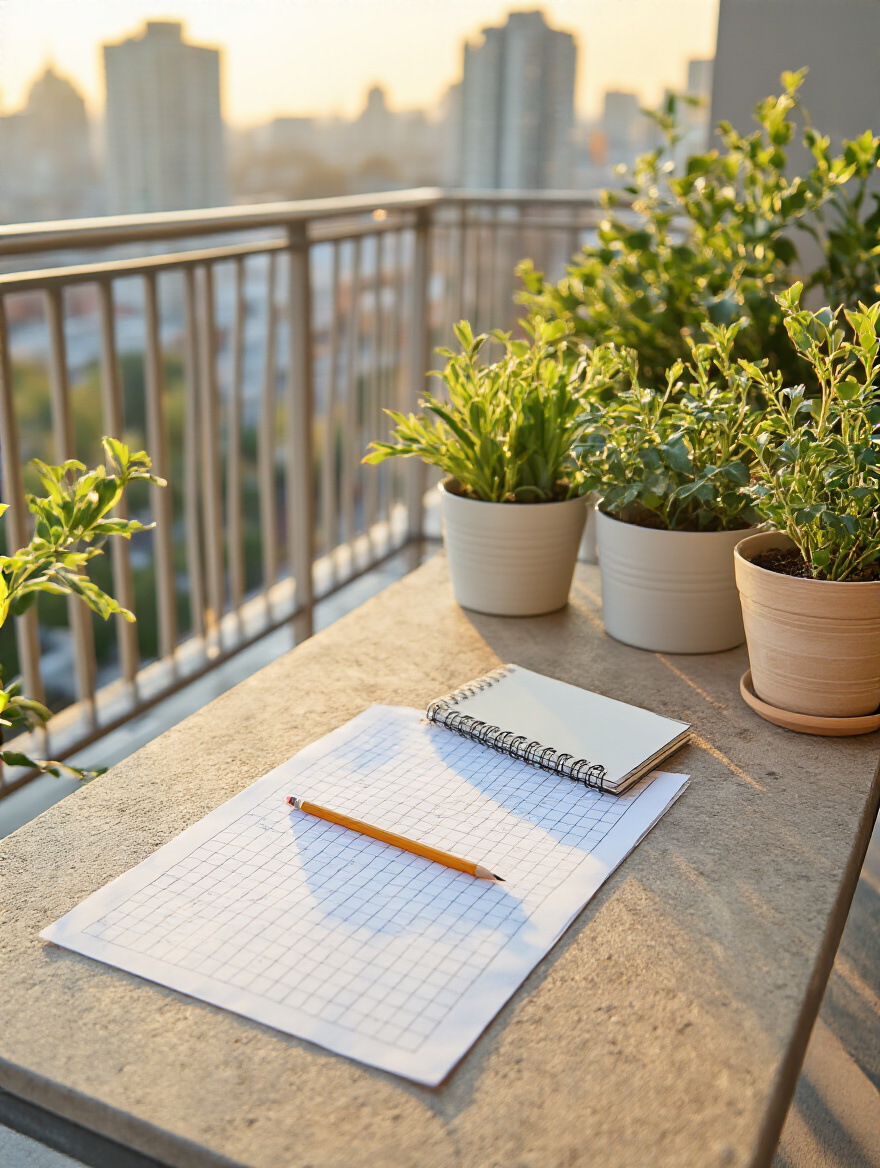
Don’t just get the length and width. Measure the height of the railing, the clearance of the door as it swings open, and any weird angles or posts. Sketch it out on a piece of paper. The ultimate shortcut is using blue painter’s tape on the floor of the balcony. Mark out the exact dimensions of the furniture you’re considering. This lets you physically feel the space, walk around it, and see if it’s too cramped before you spend a dime. It’s a game-changer.
Knowing your numbers is one thing, but knowing what you want to do in that space is everything.
4. Define Your Balcony’s Primary Purpose for Optimal Layout.
I used to think designing a space was just about making it look good. Then I learned the hard way that if a space doesn’t have a clear purpose, it becomes a magnet for clutter. A balcony without a purpose isn’t an outdoor oasis; it’s an outdoor junk drawer. You have to decide what you want to do there. Is this a reading nook for one? A coffee spot for two? A mini-garden for fresh herbs? A place to do yoga?
You can’t do it all, especially on a small balcony. Pick one, maybe two, primary functions. This choice will guide every single other decision. If it’s a reading nook, you’ll prioritize a ridiculously comfortable chair. If it’s a dining spot, a bistro set is your hero.
“A space without a clear purpose will never feel right. It will always feel a little chaotic because your brain doesn’t know what it’s supposed to do there.”
Defining the “what” makes the “how” fall into place effortlessly. The BS is trying to cram a lounge chair, a dining table, and a garden into a 5×8 foot space. You’ll end up with a space that’s good for nothing.
Once your intention is set, it’s time to prepare your canvas for the masterpiece to come.
5. Clean Balcony Surfaces Thoroughly for a Fresh Decorating Start.
I know, cleaning is a drag. But putting beautiful new furniture and rugs on a dirty, grimy surface is like putting on a brand new outfit without taking a shower first. It just feels wrong. That layer of city grime, pollen, and cobwebs isn’t just ugly; it can cause your new items to degrade faster. Giving your balcony a deep clean is a psychological reset. It signals a fresh start.
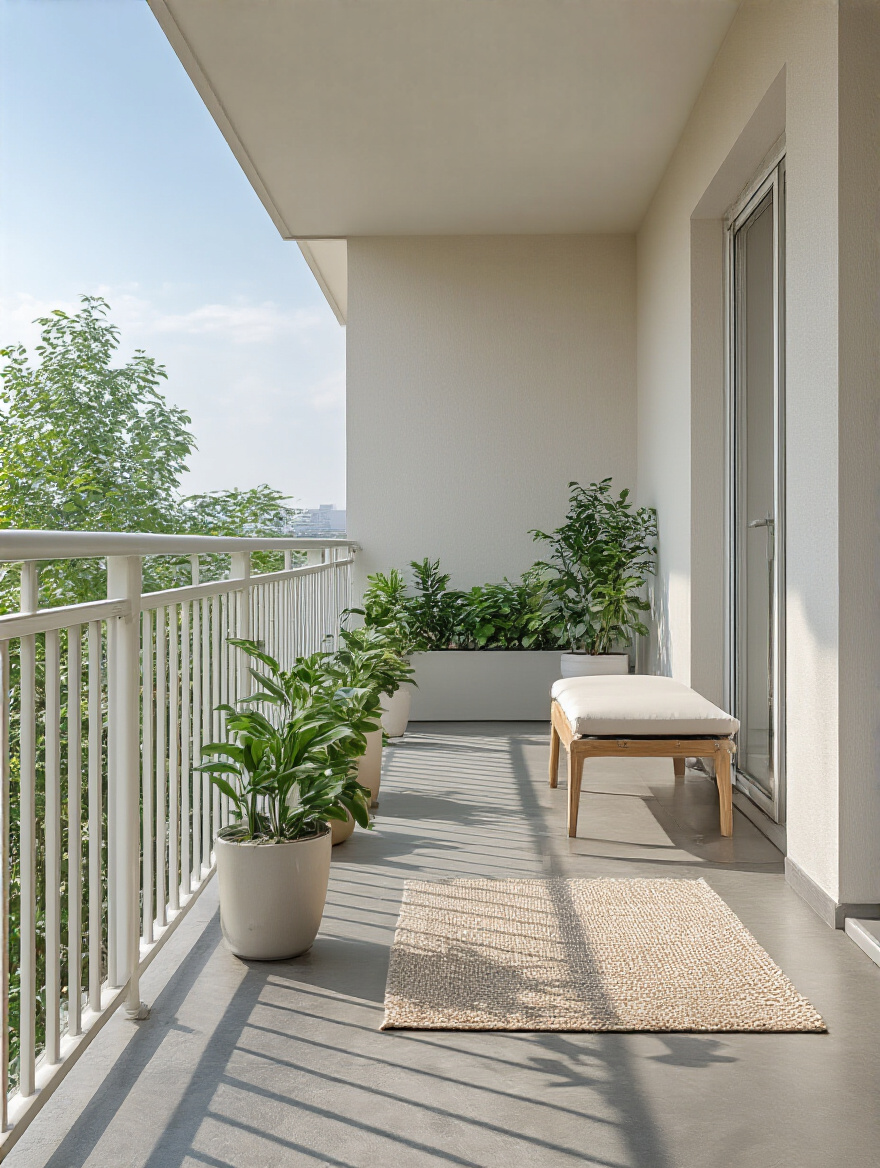
This doesn’t have to be complicated. Sweep away all the loose junk. Then scrub everything—floor, railings, even the part of the wall you can reach—with a bucket of soapy water and a stiff brush. Rinse it all down and, this is crucial, let it dry completely. Starting with a truly clean slate makes your new colors look brighter, your textures richer, and the whole space feel instantly more inviting. It’s the least glamorous step, but it has one of the biggest impacts.
Optimizing Comfort & Practicality
With a safe and clean foundation, we can now get to the fun stuff: making your balcony a place you actually want to spend time. This is about tricking your brain into thinking this outdoor slab is just as cozy and functional as your living room.
6. Select Space-Saving Folding Furniture for Flexible Seating.
Here’s the deal with small spaces: flexibility is everything. Fixed, heavy furniture on a small balcony is a commitment you’ll probably regret. It locks you into one layout and can make the space feel permanently cramped. Folding furniture, on the other hand, is a superpower. It allows your balcony to be a dining area one night and an open space for stretching the next morning.
I’m not talking about flimsy camping chairs. There is a whole world of beautifully designed, sturdy folding bistro sets, wall-mounted drop-leaf tables, and collapsible benches. They give you the function when you need it and the space back when you don’t. This ability to transform the space is psychologically freeing. It makes the small area feel abundant with possibility rather than limited by its size. The BS is thinking you need a big, permanent setup to feel “luxurious.” True luxury in a small space is options.
Now that you have flexible seating, let’s address the cold, hard floor beneath your feet.
7. Install Weather-Resistant Outdoor Rugs to Define Your Zone.
Nothing says “this is just a slab of concrete” more than, well, a slab of concrete. An outdoor rug is the single fastest way to make a balcony feel like a legitimate room. It’s a powerful psychological cue that defines the space, anchors the furniture, and signals to your brain: “This is a designated zone for relaxation and comfort.” The tactile feeling of something soft underfoot instantly elevates the experience.
You have to use a rug made for the outdoors—typically from a synthetic material like polypropylene. It will resist mold, mildew, and fading from the sun. An indoor rug will become a disgusting, soggy mess after the first rain. The shortcut here is to not buy a rug that covers the entire balcony floor. You want to leave a border of flooring visible around the edges, which actually makes the space feel larger and more intentional.
With the ground covered, it’s time to create a sense of personal space by looking at your sightlines.
8. Enhance Privacy with Stylish Bamboo Screens or Lattice Panels.
You can have the most beautiful balcony in the world, but if you feel like you’re on display for all your neighbors, you’ll never truly relax out there. Privacy is a fundamental human need. Creating a sense of enclosure, even a partial one, gives your nervous system permission to stand down. It turns an exposed perch into a secluded sanctuary.
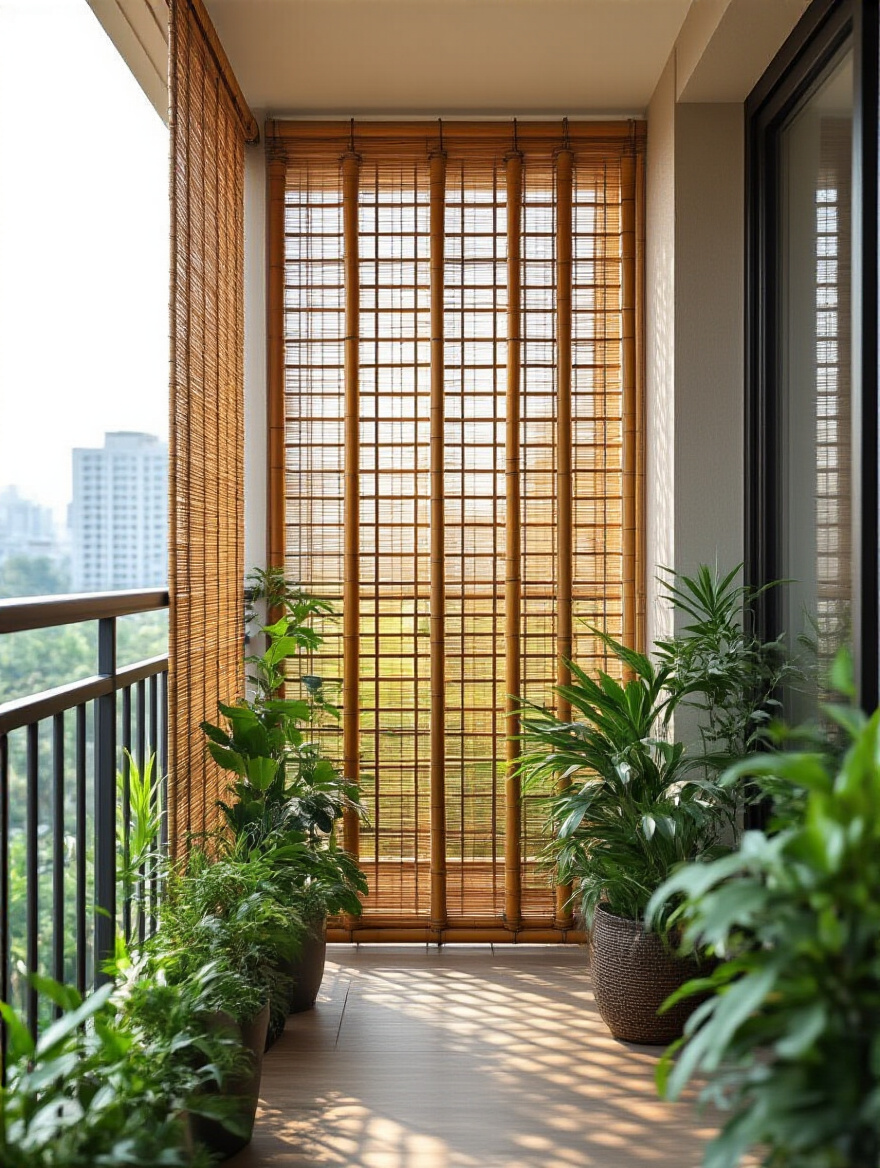
Rolled bamboo fencing or expandable faux-ivy lattice panels are fantastic, renter-friendly solutions. You can easily attach them to existing railings with zip ties—no drilling required. This simple addition can block a direct line of sight, filter harsh sunlight, and even dampen a bit of city noise. The goal isn’t to build a fortress, but to create a subtle visual barrier that lets your subconscious mind know that this little patch of the world is yours.
Your private nook is now defined, so let’s make it as comfortable as your favorite armchair.
9. Choose Durable Cushions and Throws for Elevated Comfort.
This is the part everyone messes up. They take their cute indoor decorative pillows and throws outside, and within a month, they’re faded, mildew-spotted, and ruined. All that money, gone. You must use fabrics designed for the outdoors. Look for materials like Sunbrella, Olefin, or solution-dyed polyesters. These are engineered to resist UV rays, repel water, and inhibit mold and mildew growth.
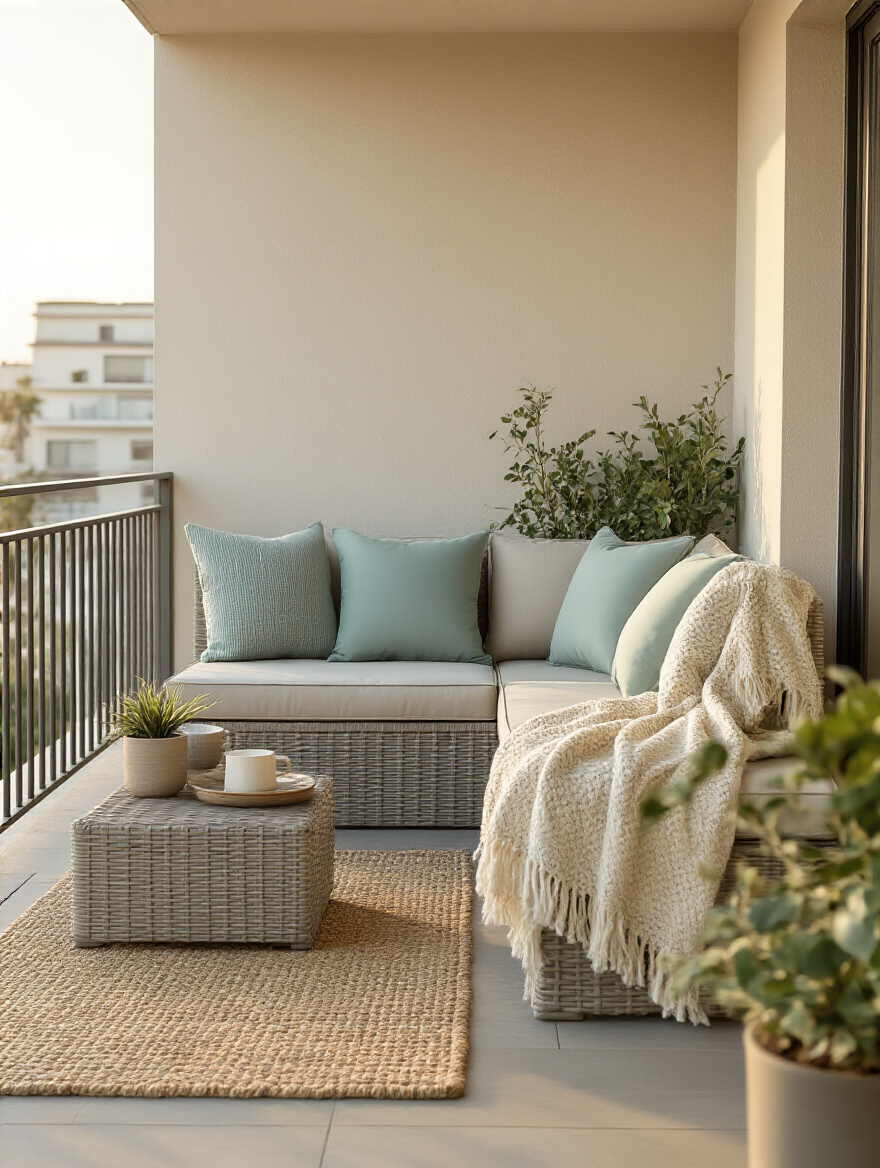
Yes, they cost a bit more upfront, but they will last for years instead of a single season. This is where you invest. Good outdoor cushions turn a hard chair into a lounge-worthy seat, making it a place you’ll linger for hours instead of minutes. A cozy outdoor-rated throw blanket for chilly evenings is the final touch. It’s what transforms the balcony from a place to sit into a place to snuggle.
To truly bring the space to life, you need, well, actual life.
10. Utilize Compact Planters for Railing or Vertical Greenery.
Floor space on a balcony is precious real estate. Don’t waste it on bulky pots if you don’t have to. Go vertical! Railing planters, wall-mounted pocket gardens, and tiered plant stands are your best friends. They draw the eye upward, making the space feel taller and more expansive, and they surround you with greenery without eating up your seating area.
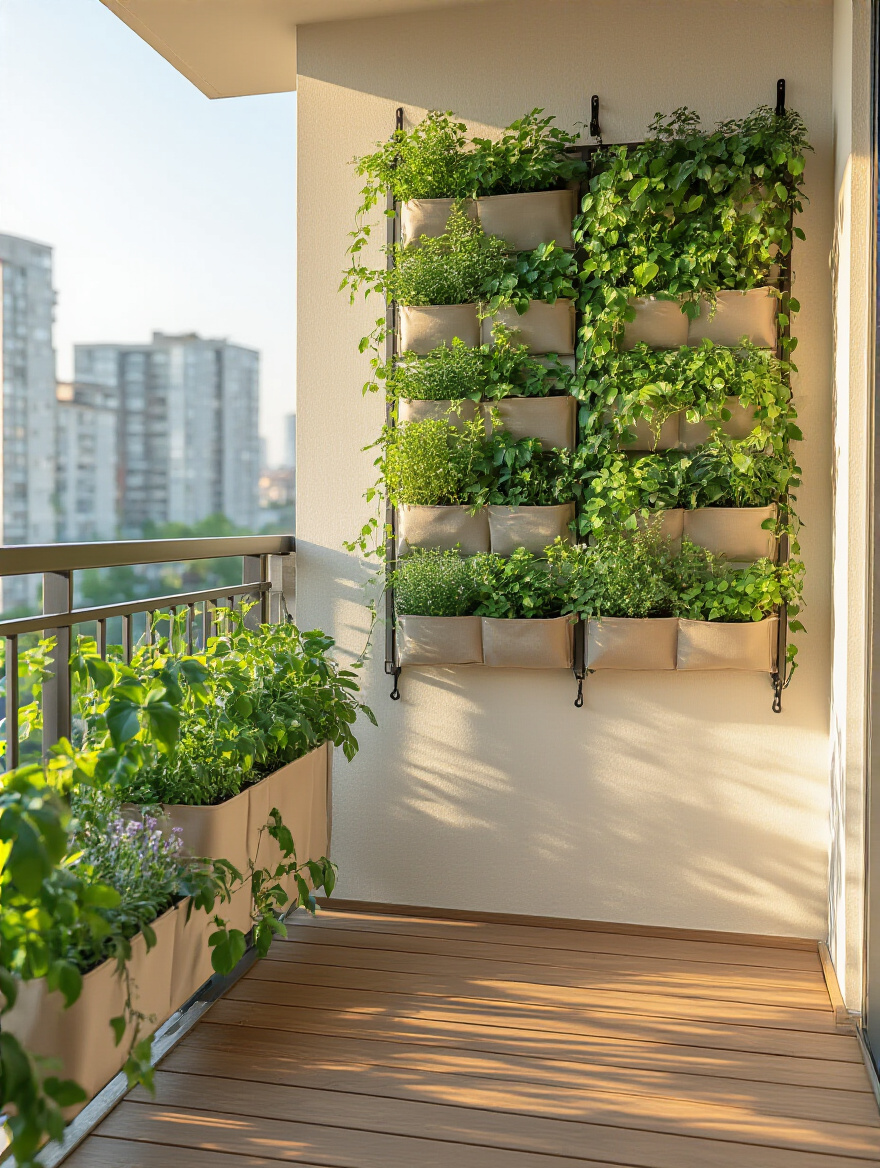
Our brains are hardwired to respond positively to nature—it’s a concept called biophilia. Even seeing a small amount of green foliage can lower cortisol (the stress hormone) and improve your mood. This isn’t just about aesthetics; it’s about tangible well-being. The shortcut I love is to get railing planters that hook securely over the railing. They are easy to install, easy to remove, and give you an instant-impact garden at eye level.
Now let’s get that flooring on par with the rest of your beautiful, comfortable setup.
11. Create Easy-Clean Flooring with Interlocking Decking Tiles.
Hate your ugly concrete floor? Interlocking deck tiles are the answer you’ve been looking for. They are one of the most transformative and renter-friendly upgrades you can make. These tiles, often made of wood or a durable composite, snap together like LEGOs right on top of your existing floor. You can cover an entire balcony in an hour, with no tools or glue needed.
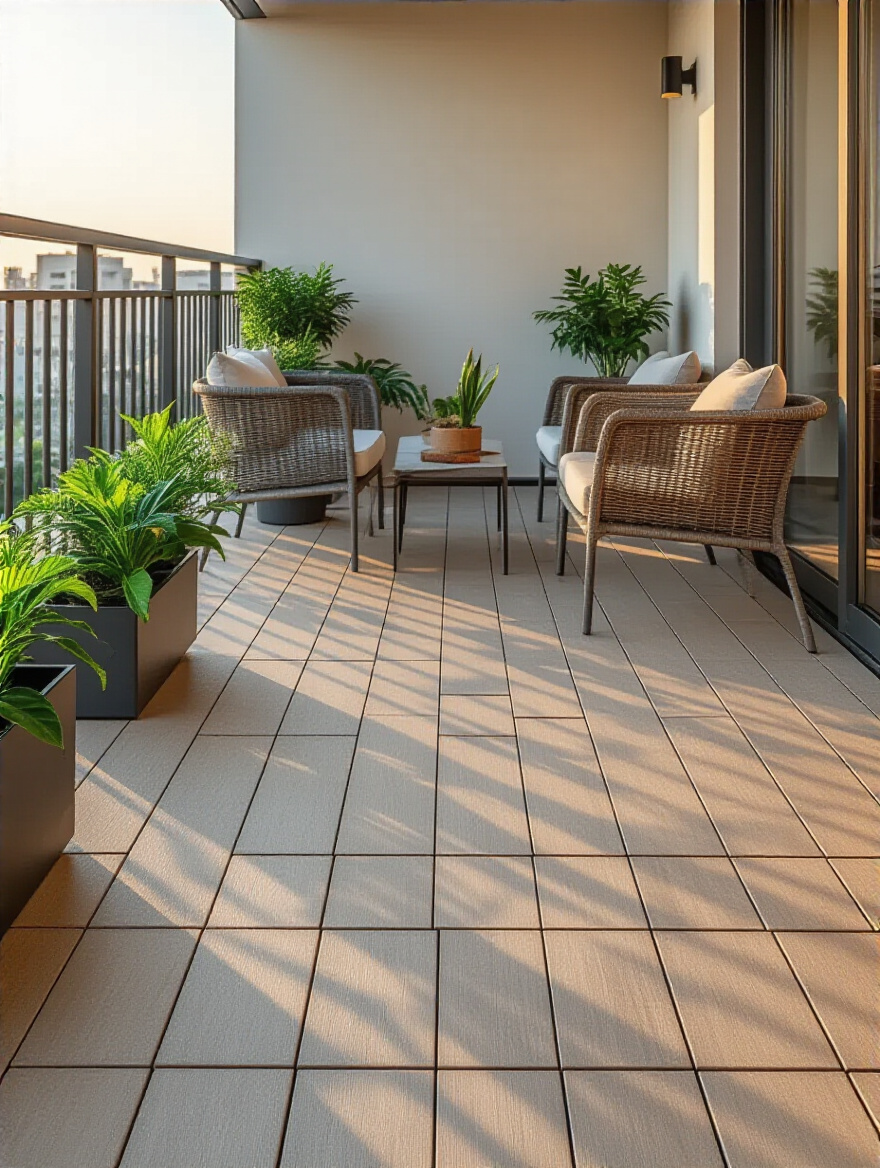
The effect is dramatic. It instantly warms up the space, making it feel more like a high-end deck and less like a utilitarian slab. They also elevate the surface slightly, which improves drainage and feels better underfoot. When you move, you can just unsnap them and take them with you. It’s a temporary solution with a permanent-feeling impact—the holy grail of apartment decorating.
You’ve invested in all these great pieces; now let’s make sure they last.
12. Protect Furniture with UV-Resistant Covers to Extend Lifespan.
Here’s the thing: The sun is trying to destroy your outdoor furniture. And so is the rain, the dust, and the bird poop. Furniture covers might seem like a hassle, but they are the single best way to protect your investment. A good set of UV-resistant, waterproof covers will literally double or triple the life of your furniture. They prevent wood from cracking, wicker from getting brittle, and cushions from fading into oblivion.
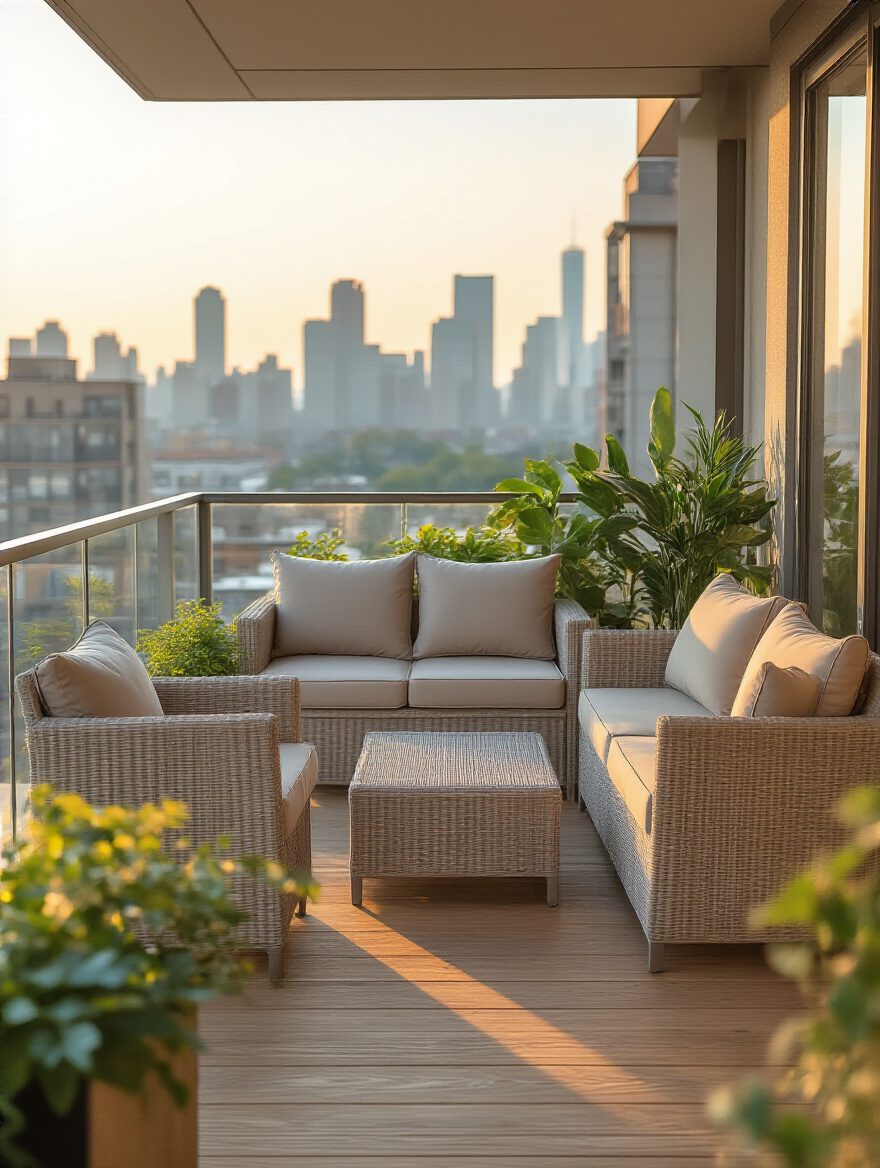
Think of it this way: a few seconds to put the covers on at night saves you hundreds or thousands of dollars in replacement costs down the line. It also keeps your furniture clean and ready to use, so you don’t have to wipe down a layer of grime every time you want to sit outside. Look for covers that have vents to prevent moisture buildup and buckles or drawstrings to secure them in the wind. This is a non-negotiable for anyone who takes their balcony seriously.
Adding Life & Enhancing Ambiance
You’ve built the comfortable, practical foundation. Now we get to sprinkle in the magic. This is about engaging all the senses—sight, sound, and even smell—to craft an atmosphere that feels truly special.
13. Design a Lush Vertical Garden Using Wall-Mounted Planters.
We talked about going vertical, but a full-on vertical garden takes it to another level. This is a statement piece. It’s living art. Systems with fabric pockets or modular stackable planters allow you to create a dense wall of foliage that can be a show-stopping feature, a privacy screen, and an herb garden all in one.
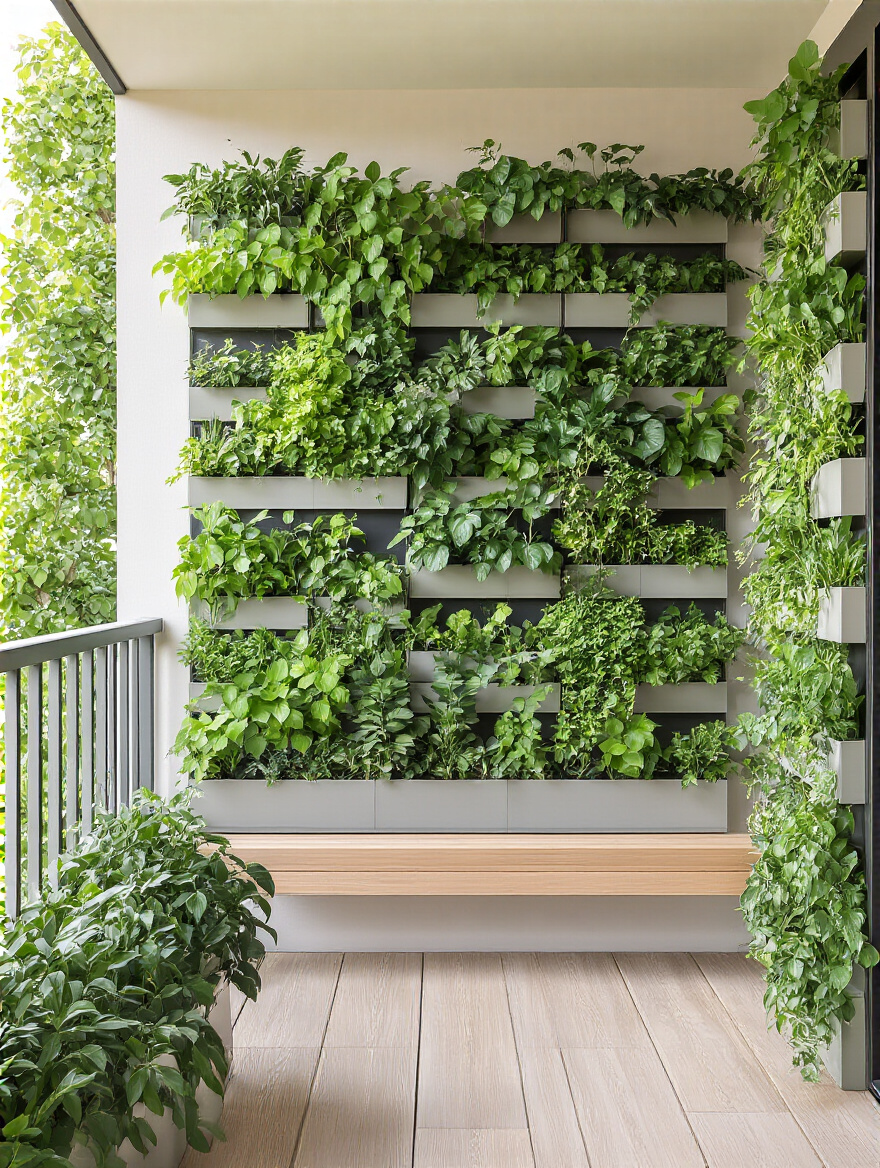
A wall of green creates an incredible sense of immersion and escape. It feels like you’re stepping into a completely different environment, separate from the city around you. The key to success here is an irrigation system. A simple micro-drip system connected to a timer will keep your plants perfectly hydrated without you having to water dozens of individual pockets every day. It’s the secret to making a vertical garden thrive instead of just survive.
Once your living wall is established, it’s time to set the mood for evening enjoyment.
14. Illuminate Evenings with Warm LED String Lights or Solar Lanterns.
The biggest mistake people make with outdoor lighting is using lights that are too bright or too cool-toned. You are not trying to illuminate a stadium; you are trying to create a magical glow. The goal is ambiance. Warm-toned LED string lights (often called “bistro” or “cafe” lights) are perfect for this. They cast a soft, golden light that is universally flattering and incredibly inviting.
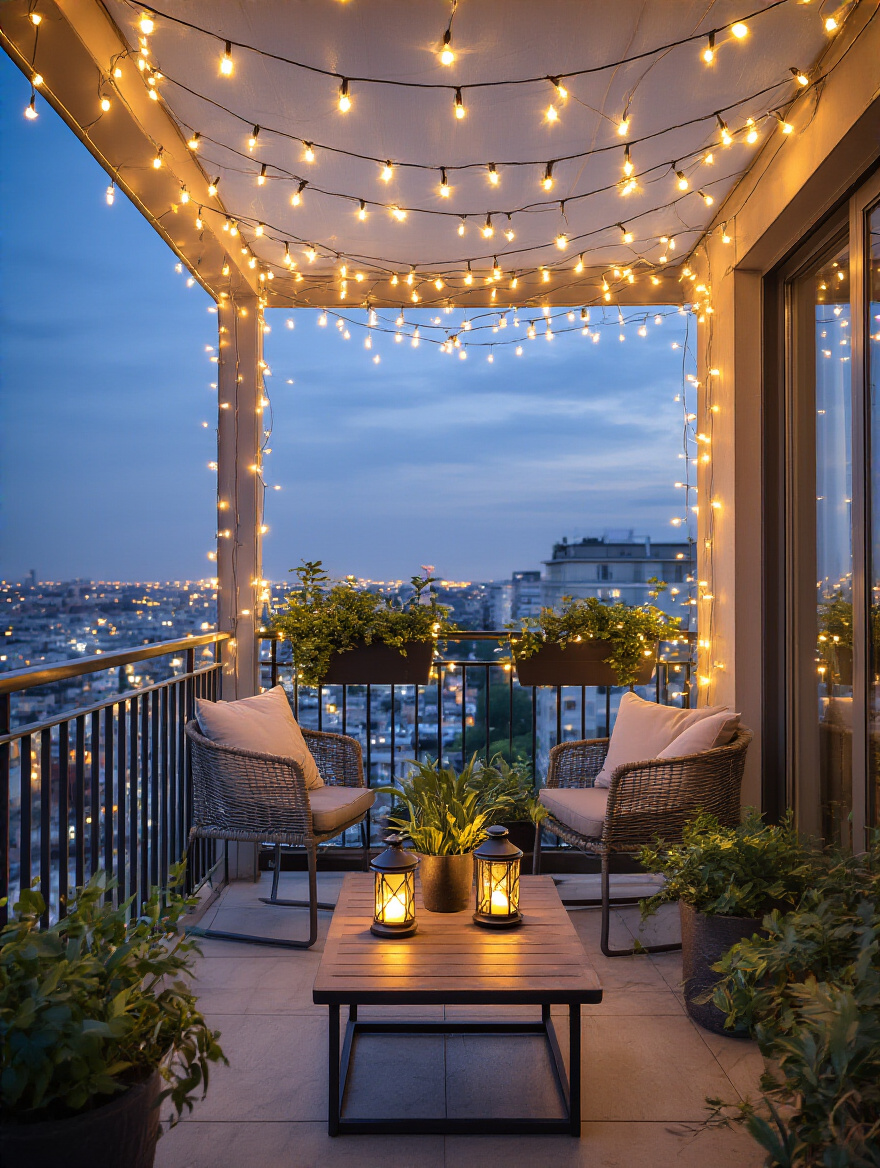
Why warm light? Our brains associate it with firelight and candlelight, which triggers deep, primal feelings of safety and community. It’s a biological hack for creating coziness. Drape them along the railing or crisscross them overhead to create a sparkling canopy. Solar-powered options are fantastic because they require no outlet and turn on automatically at dusk, welcoming you outside every single evening.
With the perfect lighting in place, you can address one of nature’s less-welcome visitors.
15. Place Scented Herbs or Citronella Plants for Natural Pest Control.
Nothing ruins a lovely evening outside faster than being eaten alive by mosquitoes. Before you reach for the chemical-laden bug spray, try using plants to your advantage. Many plants have essential oils in their leaves that naturally repel insects. Mosquitoes, in particular, dislike the scent of citronella, lavender, rosemary, mint, and lemon balm.
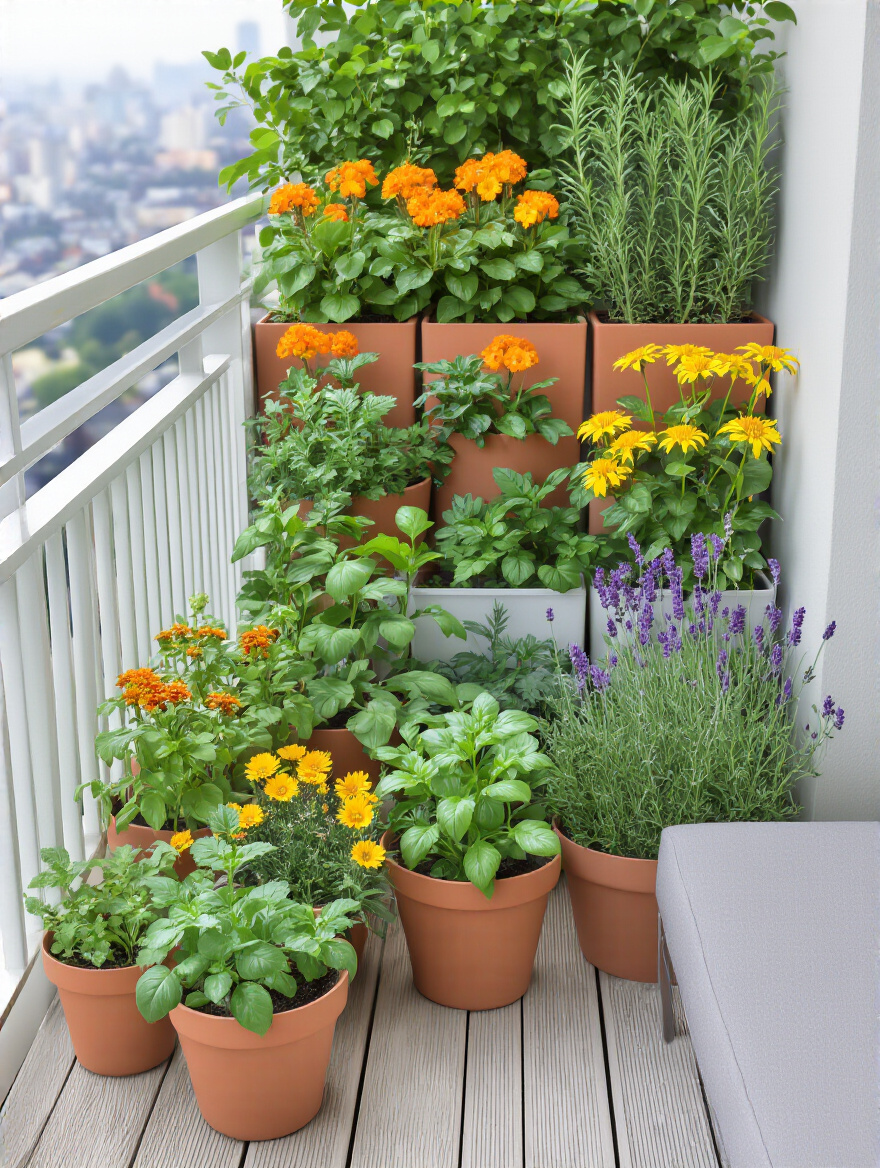
Clustering these plants in pots around your seating area creates a fragrant, natural barrier. Plus, you get the added benefit of having fresh herbs for cooking and cocktails! To get the most out of them, just gently brush your hands over the leaves when you sit down. This releases the oils into the air, amplifying their pest-repelling power and creating a wonderful aroma. It’s a multi-sensory win.
Beyond deterring bugs, consider what you want your balcony to sound like.
16. Incorporate Portable Bluetooth Speakers for Enjoyable Outdoor Audio.
Music is a powerful tool for shaping mood. A small, weather-resistant Bluetooth speaker allows you to curate the perfect auditory environment for your balcony. You can play a high-energy playlist for a happy hour with friends, a calming ambient soundtrack for your morning meditation, or a fascinating podcast while you water your plants. It gives you complete control over the vibe.
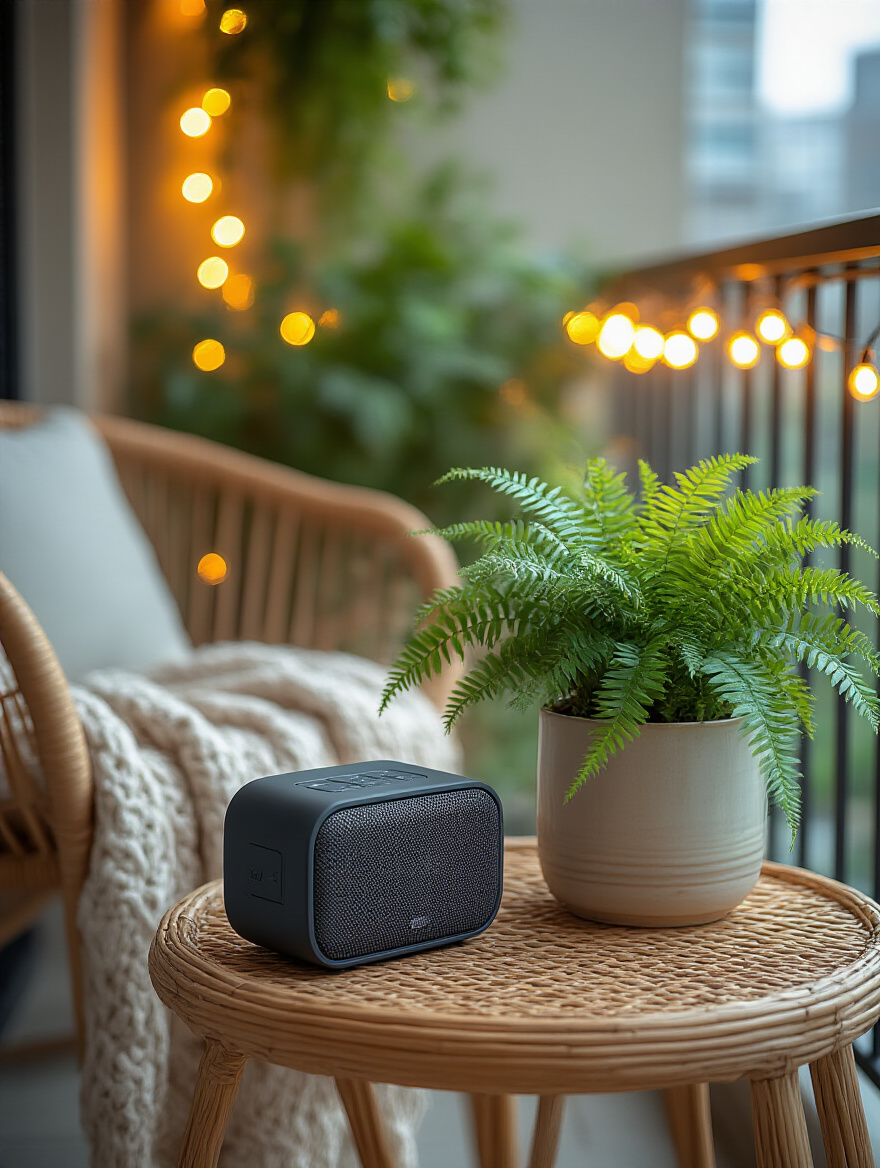
The key here is to be a good neighbor. You don’t need to blast the music. The goal is to create a personal bubble of sound, not to provide entertainment for the entire building. Placing the speaker on the floor or in a corner can help contain the sound and improve the bass response. A speaker with a long battery life is your best bet so you don’t have to worry about wires or frequent recharging.
Now that you have control over the sound, you can invite some of nature’s more welcome guests.
17. Attract Local Wildlife with Bird Feeders or Butterfly-Friendly Plants.
In a concrete jungle, your balcony can be a vital little outpost for nature. Putting up a small bird feeder or planting flowers that attract butterflies and bees adds a dynamic, living element to your space that is endlessly fascinating to watch. It’s like having your own personal nature documentary right outside your window.
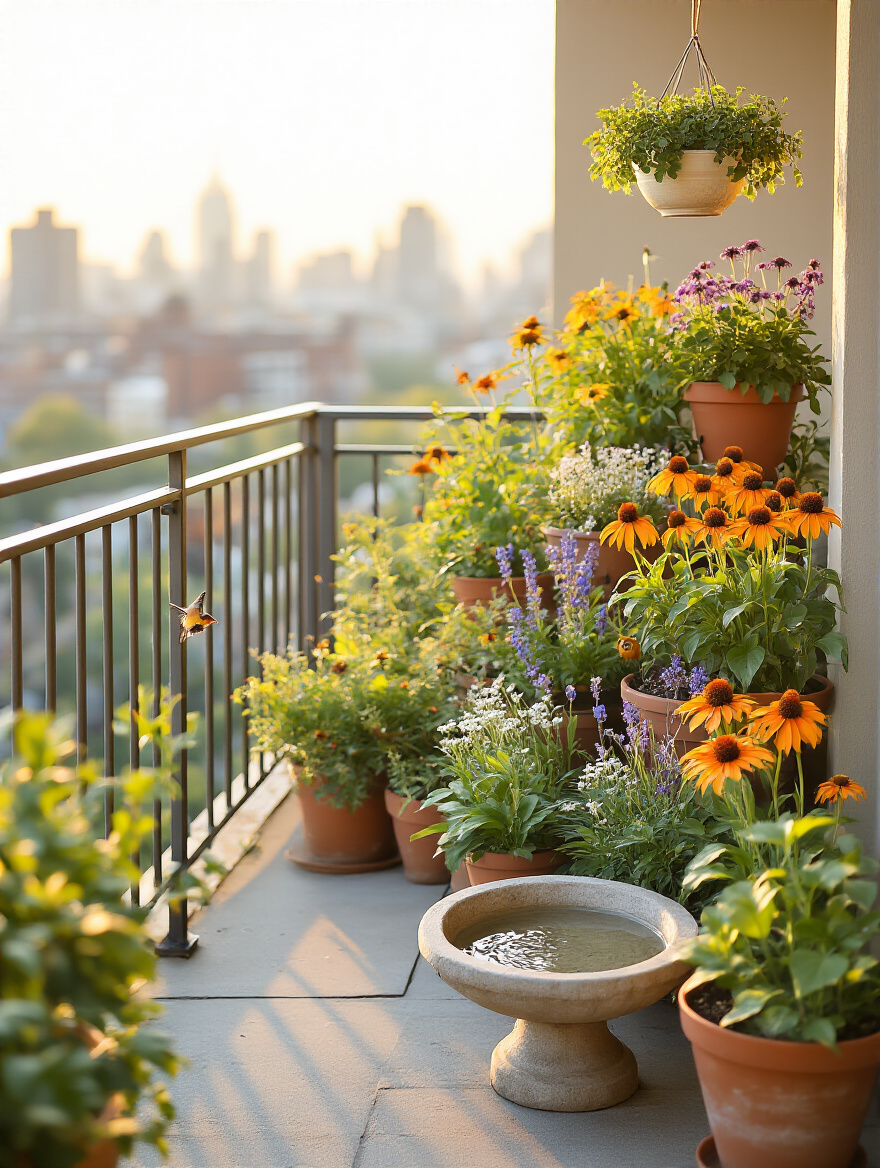
This act of “re-wilding” a small urban space has profound psychological benefits. It fosters a connection to the natural world and its cycles, which can be incredibly grounding in a fast-paced city. Choose native plants whenever possible, as they are best suited to support your local ecosystem. Remember that a bird feeder comes with a responsibility: you must keep it clean to prevent the spread of disease among the bird population.
To deepen that natural, calming atmosphere, there’s nothing quite like the sound of water.
18. Add Small, Tranquil Water Features for Calming Sensory Input.
The gentle sound of trickling water has an almost magical ability to soothe the mind. It helps to mask jarring city noises like sirens and traffic, replacing them with a sound that signals peace and tranquility to our brains. You don’t need a massive fountain; there are plenty of small, self-contained tabletop or wall-mounted water features that are perfect for a balcony.
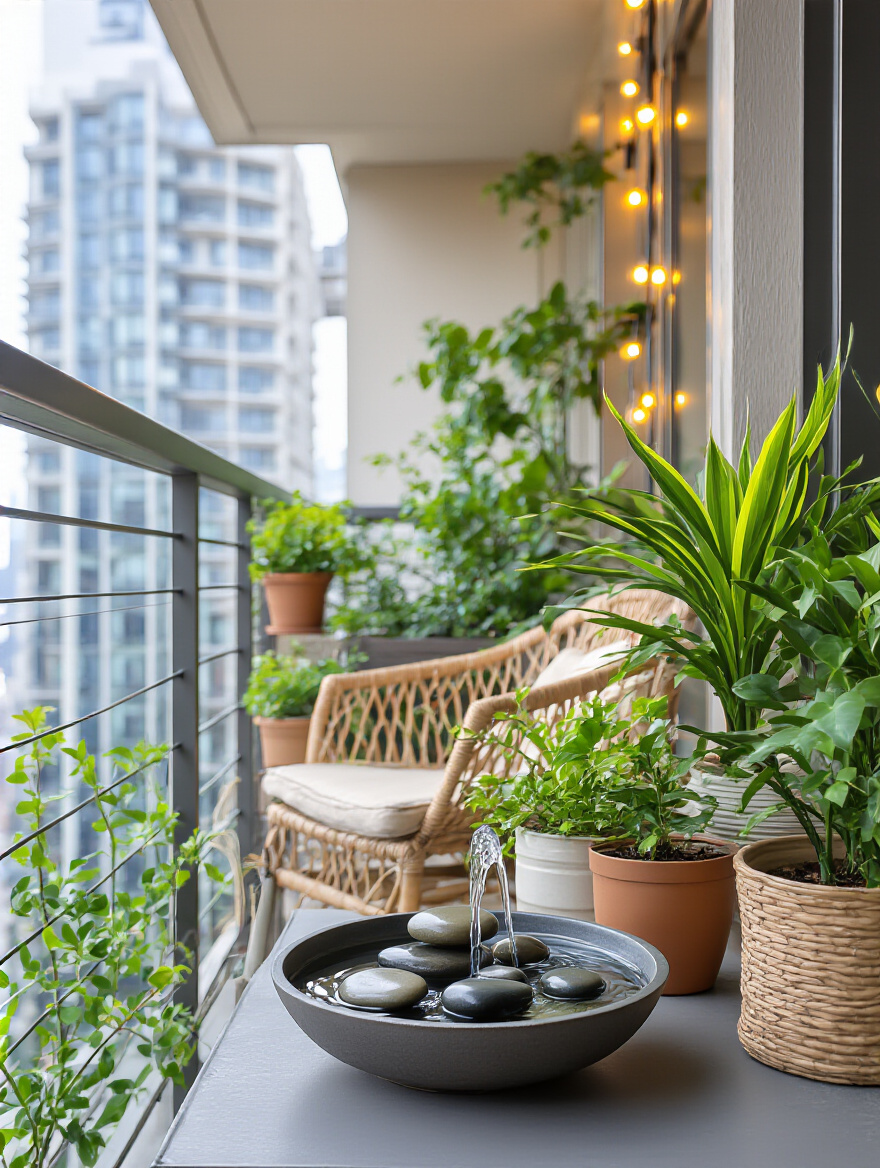
Look for a solar-powered model to avoid the need for an electrical outlet. The trickling water not only provides a calming soundtrack but also adds a bit of humidity to the air, which can be great for surrounding plants. This small addition can have an outsized impact on the overall sense of serenity, making your balcony feel like a true spa-like escape.
Smart Solutions & Niche Adaptations
You’ve mastered the essentials of comfort and ambiance. This final section is for taking your balcony to the next level—adapting it for specific, highly functional uses that can genuinely improve your day-to-day life.
19. Establish a Compact Herb Garden for Fresh Culinary Delights.
There is a unique and wonderful power that comes from being able to walk a few steps and snip fresh herbs for your dinner. A balcony herb garden is one of the most practical and rewarding uses of the space. The flavor of freshly picked basil, mint, or rosemary is worlds away from the stuff you buy in a plastic clamshell at the grocery store.
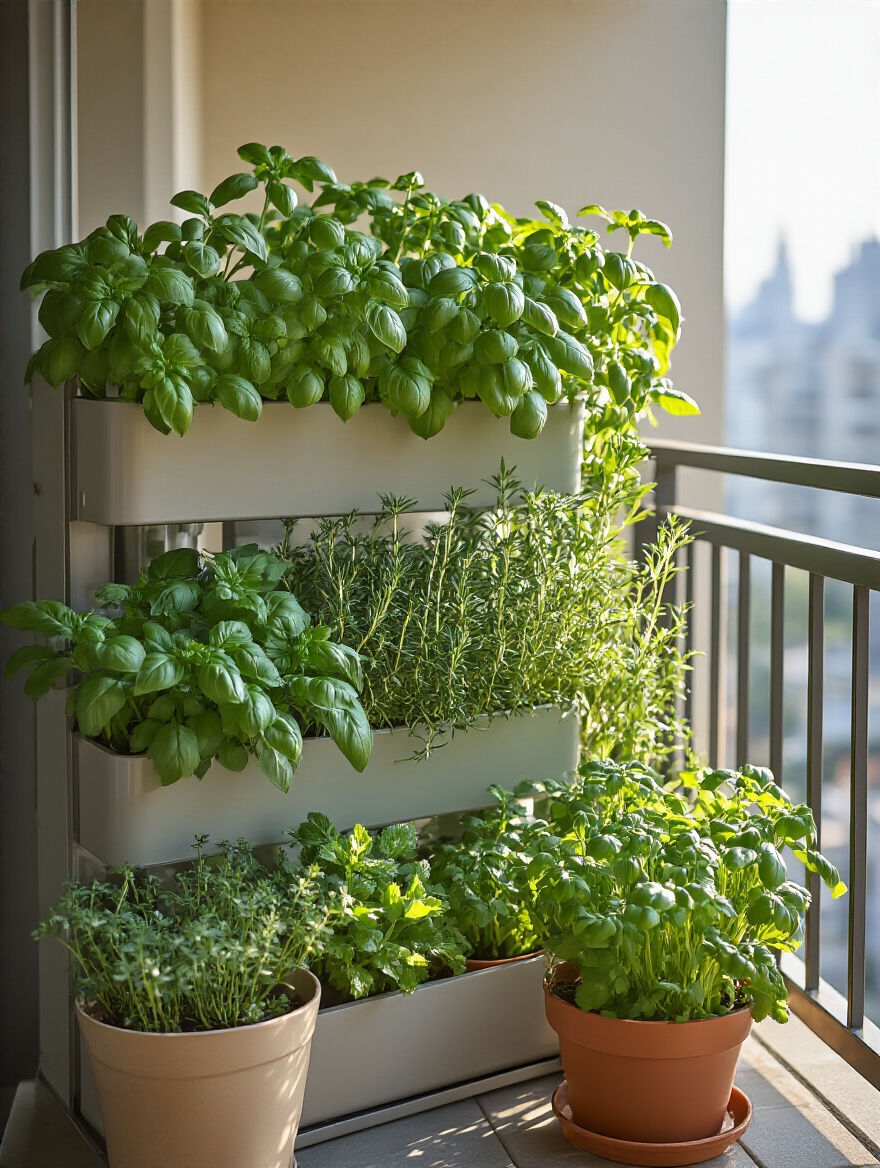
You don’t need a huge amount of space. A few pots, a railing planter, or a small vertical wall planter can provide a surprising bounty. Start with easy, high-yield herbs like mint (keep it in its own pot, it’s a bully!), basil, chives, and thyme. This simple act connects you to your food, saves you money, and elevates your cooking with almost no effort.
Just as your balcony can feed your body, it can also feed your mind and your career.
20. Set Up a Minimalist Outdoor Workspace for Productive Fresh Air.
If you work from home, you know the struggle of staring at the same four walls all day. Moving your workspace to the balcony for an hour or two can be a game-changer for your focus and creativity. Natural light and fresh air are proven productivity boosters. The change of scenery provides a mental reset that can help you power through a tough project.
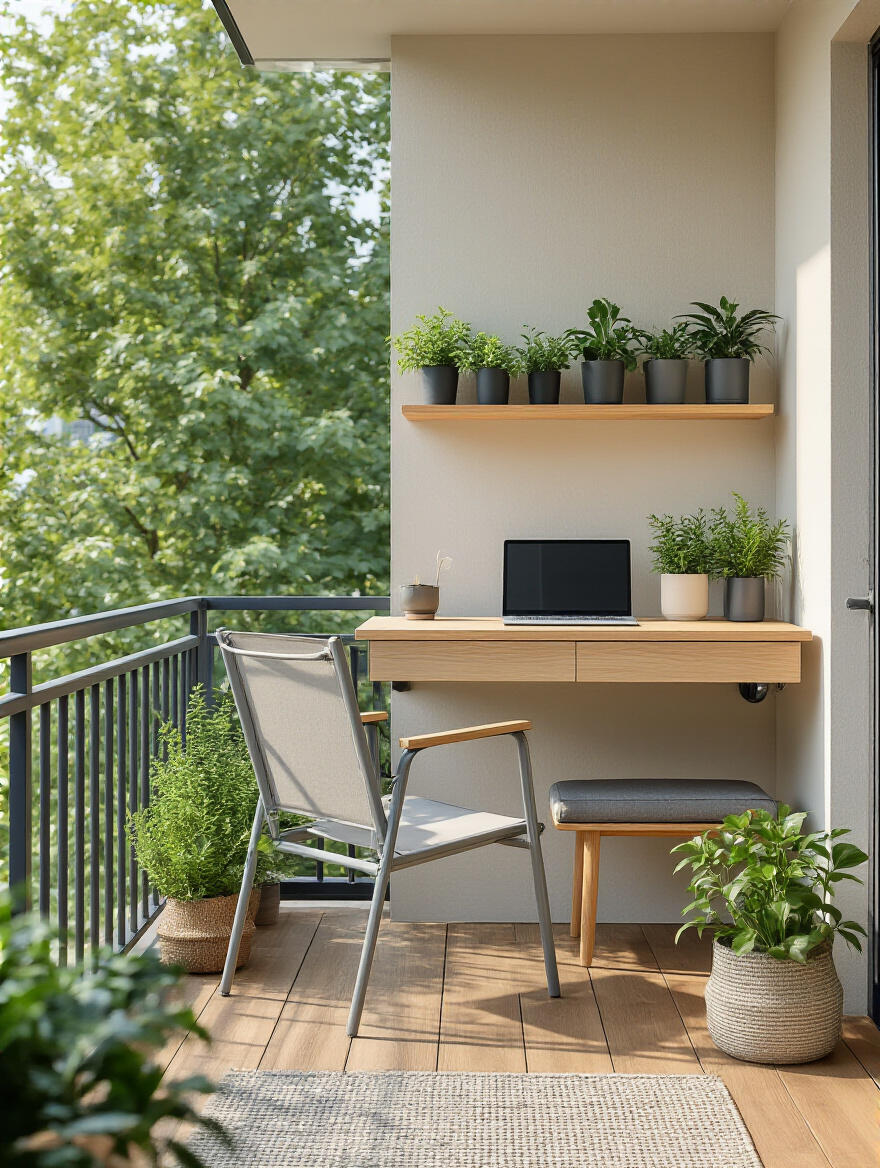
You don’t need a full office setup. A small, wall-mounted folding desk and a comfortable chair are all you need. The key is to manage screen glare—work during times of day when the sun isn’t directly on your screen, or use a small umbrella for shade. Having a dedicated outdoor spot for deep work can break up the monotony of the workday and make working from home feel like less of a trap.
To make that balcony garden even easier to manage, why not let technology do the hard work for you?
21. Integrate Smart Watering Systems for Effortless Plant Hydration.
I confess: I used to be a chronic plant killer. The culprit was almost always inconsistent watering. Smart watering systems are the solution. For a balcony, this could be as simple as self-watering planters with a built-in reservoir, or a small drip irrigation kit connected to a battery-powered timer. These systems deliver a slow, steady supply of water directly to the plant’s roots.
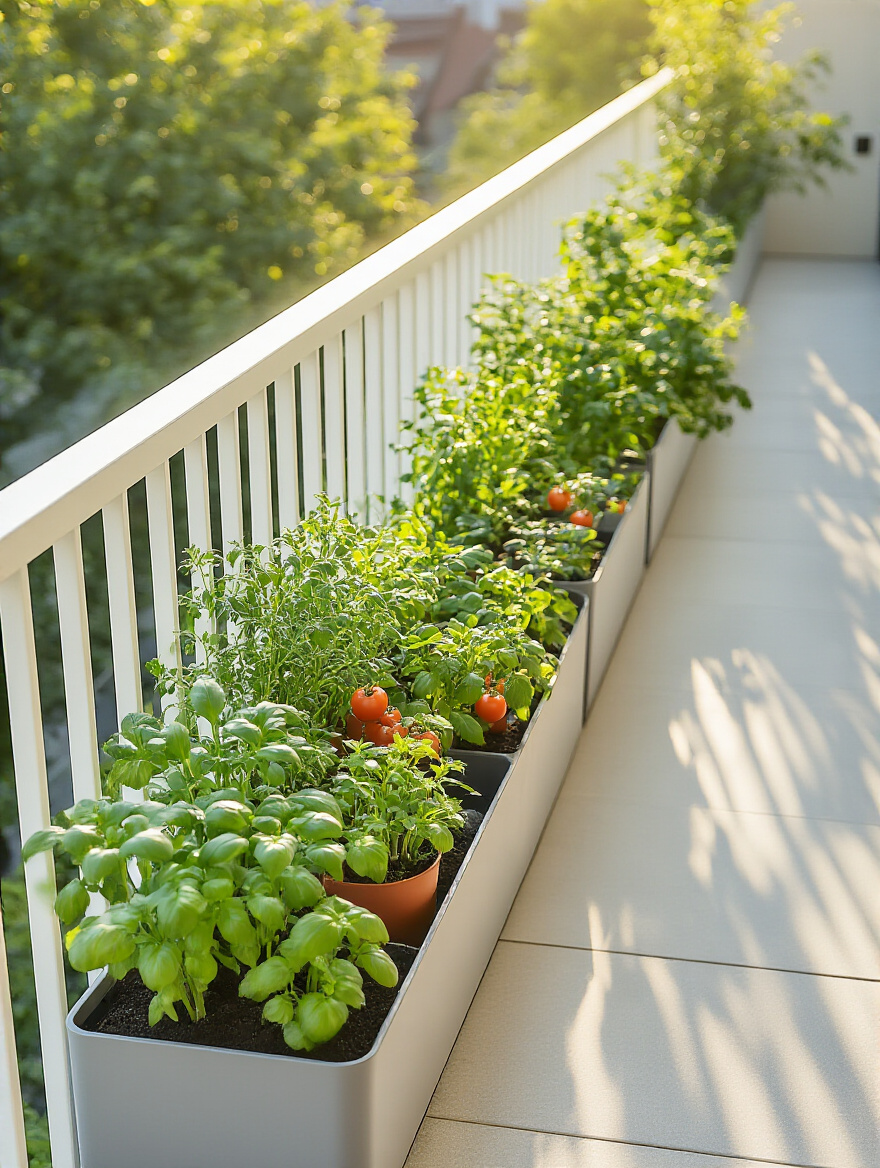
This takes the guesswork out of watering and is an absolute lifesaver if you’re busy or travel frequently. Your plants will be healthier because they’re getting consistent moisture, and you’ll be less stressed knowing they’re taken care of. It’s a small investment that pays huge dividends in lush, thriving plants and your own peace of mind.
Finally, for the ultimate in easy living, choose materials that do the cleaning for you.
22. Implement Self-Cleaning Materials for Low-Maintenance Balcony Living.
This sounds like science fiction, but it’s real. There are innovative coatings and materials designed to repel water and dirt. You can buy superhydrophobic sprays to treat your glass railings, causing water to bead up and roll right off, taking dirt with it. There are also outdoor fabrics with stain-resistant finishes and composite decking materials that are capped with a non-porous layer that resists mildew and grime.
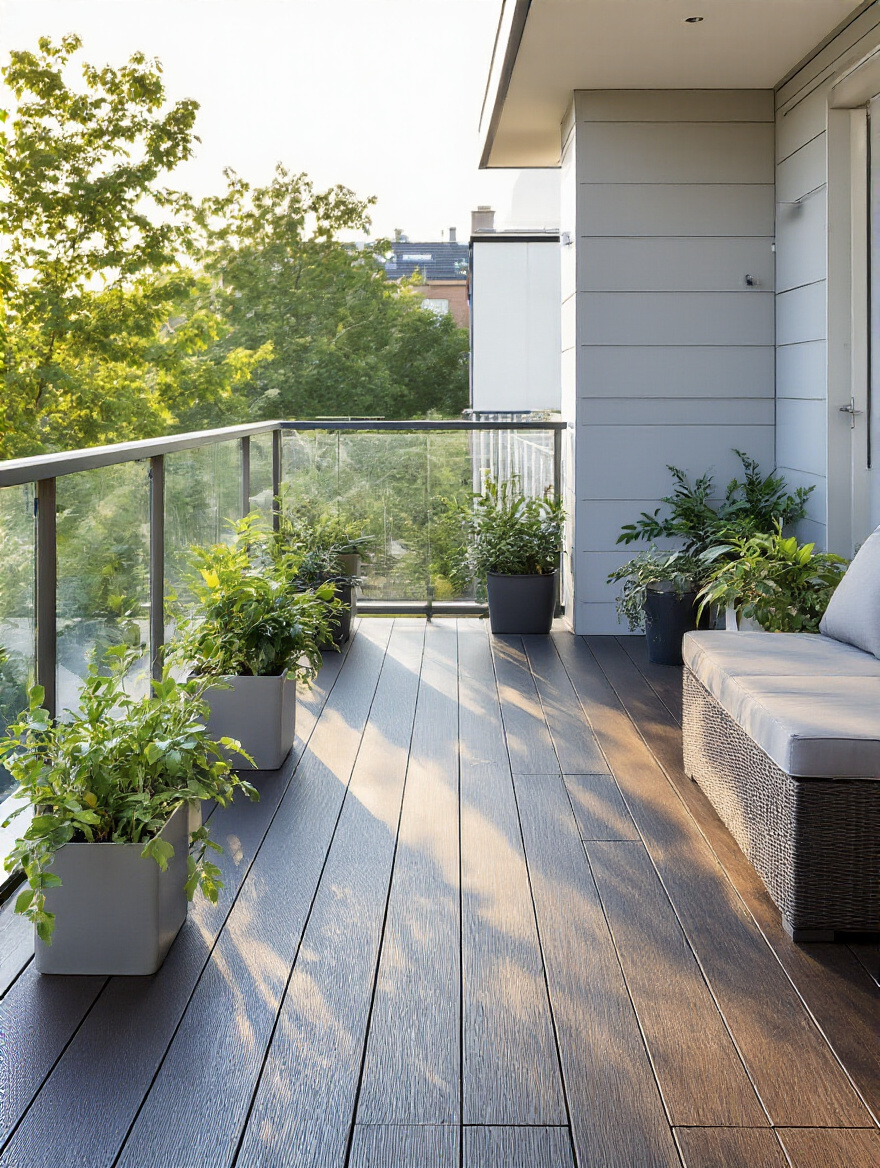
While nothing is truly “zero-maintenance,” opting for these low-maintenance solutions from the start drastically reduces your cleaning chores. It means you spend more time enjoying your beautiful balcony and less time scrubbing it. In a busy life, that’s the ultimate luxury—a space that looks after itself so you don’t have to.
Conclusion
Your balcony doesn’t have to be an afterthought. It is a powerful, valuable extension of your home and your life. By moving beyond just aesthetics and thinking about the psychology of the space—how it makes you feel—you can craft an outdoor room that genuinely serves you. It can be your quiet escape, your social hub, your productive workspace, or your connection to nature.
Don’t feel like you have to do all of these things at once. Start with one. What is the one change that would have the biggest impact on your life right now? Is it privacy? A comfortable place to sit? Some mood lighting? Pick your priority and begin there. You’ll be amazed at how a few intentional choices can completely transform a sad patch of concrete into the most loved room of your apartment. Go unlock its potential.
